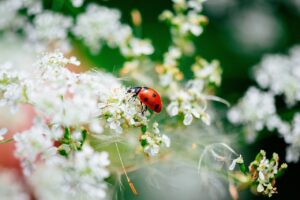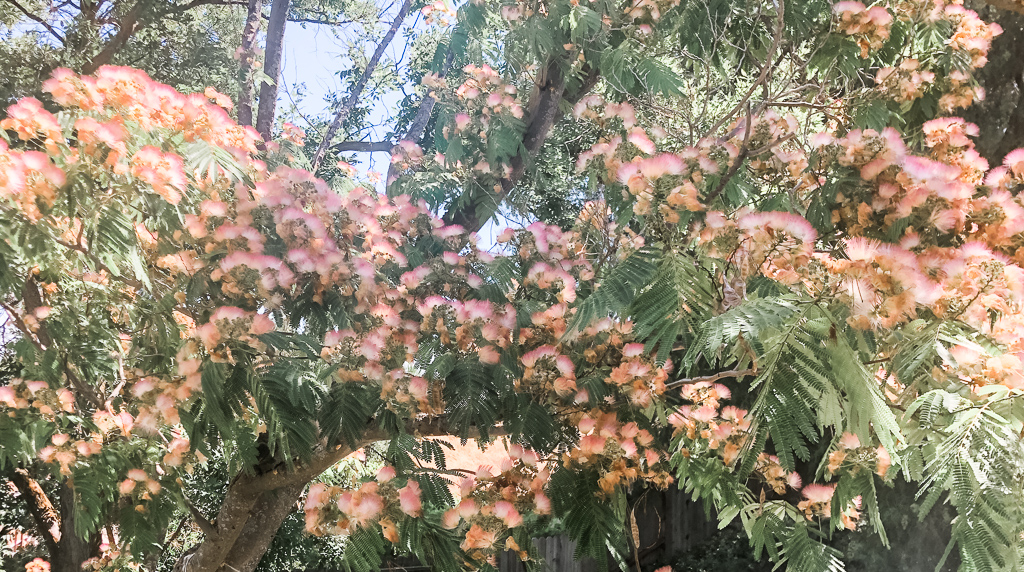The earth laughs in flowers.
—RALPH WALDO EMERSON, American essayist, lecturer, philosopher, and poet
The earth may laugh in flowers, but my mimosa tree is snort-chuckling her snotty pink puffballs all over my yard. Even the hydrangeas are waving their white flowers in surrender as if to say, enough already—we know the stage is yours now—you’re just being obnoxious!
It’s 9 a.m and I’m leaf-blowing the yard even though the gardener arrives at 2 p.m. to do the same. I just feel bad that Christian will arrive on a Friday afternoon, the last account of the day and soon to be free for his weekend revelry, only to find my yard snot-teepeed. He’ll probably wish he’d never taken my account.
The mimosa tree’s brouhaha pushed me past my tolerance and forced me to spew noise pollution from the blower into the delightful summer morning. The kind where you’d like to sit under the gazebo, sip coffee potion from your favorite mug, and listen to soft Spanish guitar riffs while the birds play musical chairs at the bird feeder.

Image by Jeremy Kyejo from Pixabay
Instead, my efforts to tidy my home torment tenants in theirs. Spiders and insects dart and run for cover at my blowing, trimming, yanking, and raking. Their beautiful homes in the mint-leaf tents and the kaleidoscope webs show their fortitude, but alas, they are no match for this giant’s wrath. The roly-polies move their little feet like a Flintstone’s car, no doubt wise to their imperilment. Then I give the plants and lawn a bath of fresh water while the birds swoop from the fence posts and feed on those creatures I displaced—they, who have already survived a house demolition, a tornado, and a flood.
This makes me feel kinda sad.
Perhaps the swaying pepper tree branches lull me contemplative, but I feel a bit tormented. Which creature should I love more? Those that would die as food or those that would die for lack of it?
This isn’t the first time I’ve questioned the universe about the whole circle of life strategy (hat tip to you if you just heard the Disney song in your head).
In my early career, before I managed a public relations department, my job was community education. I gave school presentations to fifth graders about vectors— animals and insects that can harm people. I taught that some vectors are beneficial at times and that we all need to live harmoniously. For example, yellowjackets can sting, sure, but they are just trying to have a day like you and me and if you don’t swat or kill them, they won’t release their pheromone that tells all the other yellowjackets to come to their aid in kamikaze force.
I thought that even vectors should live if they weren’t harming people. My colleagues told me I was in the wrong business.
But, twice the kids made me question not only my profession but humanity.

The first time, I shared a box of beautifully preserved butterfly specimens carefully curated by my colleague, a Ph.D. entomologist. Most children marveled at the display. They oohed and awed at their beauty, their wingspans, their symmetrical design, and their colors. All except one boy who stood in the middle of the classroom and glared at me.
“You’re a murderer!” he said.
Silence.
From me—the crises communicator. From me—the expert who goes on television to assure the public in times of disease outbreaks. From me—the public relations gal who designs communication strategies but couldn’t think of one.
“No. No. We, um, found these and, um, saved them for everyone to see,” I said, giving an emoji smile.
“Nuh-uh. You’re a murderer!” he said again, his arms crossed.
His disgust still haunts me all these years later.
The second time I was at another school. A row of creatures in cages and glass fish tank containers lined the countertop some 20 feet in the classroom. The collection included a rabbit, a snake, a guinea pig, a tarantula, a hamster, and more. Each animal’s home included a handmade sign with the animal’s name. Handmade paper flowers, colorful ribbons, star stickers, and fuzzy balls adorned the houses. Clipboards for each animal stood ready with a checklist of children’s names for each to check-out the creature, take it home, feed it, care for it, and love it.
I walked the length of the classroom admiring the love and care these animals received until I reached the last container: death row. There was no name. No flowers. No bright, crafty things. The glass was cloudy and smudged. There was no clipboard to ensure timely cage cleaning or feeding of the white mice within, let alone a checkout system for giving love.
A boy with dark wavy hair tapped on the white rabbit’s cage next door. “Hey, Thumper. Hey, little Thumper,” he sang. And then he looked at me staring at the mice and said, “Oh, those? Food for the snakes.”
The unfairness is as insurmountable as my turmoil is effective.
Snakes have to eat, too, I suppose.
Mother Nature doesn’t play fair, but she’s an apt architect.
I’d best leave her to it.


1 comment
[…] wrote about the diversity of life in my backyard before, but now my senses are keener; my wonder gauge ramped up. I no longer need to go […]